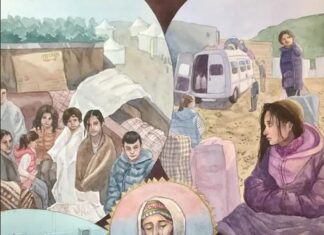By Liana Satenstein
HOUSTON (Vogue) — Olivia Haroutounian is not your typical college student. The visually arresting 22-year-old looks plucked out of a Pre-Raphaelite painting with long black curly hair and old-world features, and frequently wears a vintage Oasis T-shirt and Manolo kitten heels. Unlike most college students with an eye for rare designer garments, she makes her fashion habit work in her favor. Her sales pay her tuition at the University of Houston, where she studies corporate communication with a minor in anthropology.
Her Depop page, where she has 26,000 followers, is a treasure trove, including a bold-print ’90s mesh tank top by the Paris-based label Xuly.Bët and a race car–inspired pair of stretchy shorts by the Japanese label Hysteric Glamour. Balancing out these indie finds are Insta–must pieces like a Jean Paul Gaultier mesh shirt with the image of Jesus and a lime-green Gianni Versace bodysuit. She’s been a collector since she was 10 years old, so it was only destiny that she become a vintage seller.
(Depop is a peer-to-peer social shopping app.)

Haroutounian grew up trawling estate sales and yard sales alongside her mother, who is a vintage clothing dealer. “She started doing it when she was pregnant with me. She didn’t want to leave me with a babysitter,” she says. While she disliked going to sales with her mother at first, Haroutounian slowly became interested in clothing. Her mother had an affinity for American designers of the ’70s, such as Stephen Burrows, Geoffrey Beene, and Norma Kamali, which sparked Haroutounian’s obsession with clothes. “I kind of fell in love with clothes there,” she says. Her first purchase was at 10 years old when she went to a yard sale of a former rock band manager. “There were ’70s clothes, like platforms and all of these really rare T-shirts,” she says. “Everything was a quarter. Ever since then, I’ve been super into collecting.” From that sale, Haroutounian has kept a Hole T-shirt, as well as an authentic John Lennon and Yoko Ono “Bed-Ins for Peace” T-shirt that she estimates is worth about $1,000.












